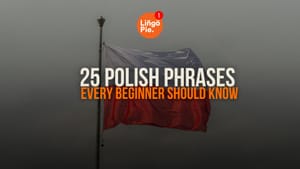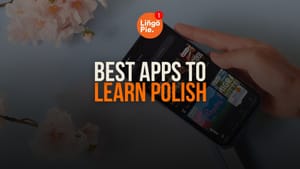Polish is ranked by the Foreign Service Institute as a Category III language, right alongside Thai, Vietnamese, and Nepali. That ranking alone can overwhelm anyone before they’ve even started. Add Lingopie’s own difficulty ranking report, and it can very much feel like you’re gearing up for Everest… in sneakers, with just a granola bar.
However, there’s one approach that slices through all that complexity and actually makes learning Polish feel doable from day one. It’s called immersive learning: surrounding yourself with real Polish content right from the get-go, even if most of it sounds like gibberish at first.
In this post, I’ll explain exactly how immersive learning works for Polish, why it’s the best way to learn Polish, and the specific resources that’ll give you the high-quality input you need to make progress.
- Polish Grammar Basics For Beginners [Guide]
- 7 Best Polish Movies On Netflix To Learn Polish
- How to Improve Your Polish Conversation Skills [5 Tips]

Is Polish Hard To Learn?
Yes, Polish is indeed challenging to learn from scratch. In fact, it’s estimated that you’ll need around 1,100 class hours for English speakers to reach proficiency. This time commitment alone puts it in the same league as Russian, Czech, and Hungarian. Some of the things that make Polish hard include:
- Highly inflected grammar system with 7 noun cases and 3 grammatical genders
- A consonant-heavy pronunciation system, along with special diacritics and phonetic rules
- Vocabulary differences and false friends
- Significant regional language differences within Poland
That said, Polish does have some things working in its favor. Unlike Mandarin or Vietnamese, there are no tones to worry about, and the writing system uses familiar Latin letters (with a few extra marks thrown in). Most importantly, that 1,100-hour estimate assumes traditional classroom learning, but people who use immersive methods often cut that time significantly.
What’s The Best Way To Learn Polish?
The best way to learn Polish is through immersive learning—and no, that doesn’t mean you need to pack your bags for Warsaw tomorrow. Immersive learning is an experiential learning approach where you surround yourself with unedited, unfiltered Polish content and let your brain naturally pick up patterns, just like how you learned your first language as a kid.
So technically, what you need to do is...
- Surround yourself with Polish content - Start watching Polish Netflix shows, listening to Polish music, or following Polish YouTubers in topics you already enjoy.
- Focus on comprehensible input - Choose content that's slightly above your current level, where you can understand the general idea even if you miss specific words.
- Make it consistent - Aim for at least 30-60 minutes of Polish exposure daily, whether that's during your commute or while cooking dinner.
- Actively engage with what you're learning - Look up interesting words, repeat phrases out loud, or try writing down sentences you hear frequently.
By doing this immersive learning approach, your brain will be busy cataloging how Polish sounds, how sentences flow together, and which words pop up most frequently. After a few weeks of consistent exposure, you’ll start noticing that certain phrases make sense even before you’ve formally "studied" them.
Does Immersive Learning Really Work?
The short answer? It works incredibly well, and there’s solid research to back that up. While most language learning studies focus on more commonly taught languages, the principles behind immersive learning are universal and apply to Polish as well.
Immersion = faster results
A PwC study found that learners trained in virtual reality environments picked things up up to 4x faster than in traditional classrooms. That’s because immersion creates context, and context makes everything stick.
Better than classrooms
A 2019 study tracked learners who used Turkish TV shows for 1–2 years. Many started with zero knowledge but eventually watched shows without subtitles, reaching B1 level in listening, speaking, and reading. The learning happened naturally and largely unconsciously—exactly what happens when Polish learners binge-watch Netflix series like "1983" or "Pakt."
Movies work (really well)
A 2024 review analyzed years of research and found that integrating movies into language learning consistently enhanced all skills—listening, speaking, reading, writing, vocabulary, and even critical thinking. Most studies showed measurable improvement through before-and-after tests.
Immersion beats traditional classrooms
A 2023 comparative study with 60 non-native English speakers found that those in immersion programs achieved significantly greater gains in language proficiency than those stuck in conventional classroom settings. The difference wasn't small—it was dramatic.
6 Immersive Resources For Learning Polish
Now that you’re convinced immersive learning works, let’s talk about the actual resources that’ll get you there. From binge-worthy Netflix series to catchy Polish pop songs, these six types of content will surround you with authentic Polish while keeping you entertained.
Remember, the key here is finding what genuinely interests you, because consistency beats perfection every single time.
Polish TV Shows

Polish television has exploded in quality over the past few years, and platforms like Netflix and Lingopie have made it incredibly accessible. Shows like "High Water," "Feedback," and "The Mire" offer gripping storylines that keep you hooked while your brain absorbs natural Polish dialogue.
What makes TV shows particularly effective is the visual context—you can often understand what’s happening even when you miss specific words, which helps your brain make connections between sounds and meanings.
To make Polish TV shows work for you, start with subtitles in your native language, then gradually switch to Polish subtitles, and eventually try watching without any subtitles at all. Lingopie takes this a step further by offering interactive dual subtitles where you can click on words for instant definitions.
Polish Movies (Short or Feature-Length)

Polish cinema offers everything from Oscar-winning dramas like "Ida" to lighter romantic comedies, exposing you to different dialects, speaking speeds, and cultural contexts. Movies work exceptionally well because they’re self-contained stories—you get a complete narrative arc in 90-120 minutes, which helps reinforce vocabulary and phrases through repetition within the same context.
Short films on YouTube or Lingopie are also perfect for beginners since they’re less overwhelming than feature-length movies. The concentrated storytelling means you’ll hear key phrases multiple times, and the shorter format makes it easier to rewatch and catch details you missed the first time around.
Games and VR (Language Settings)
Switching your favorite video games to Polish creates an immersive environment where you're constantly exposed to the language while doing something you enjoy. Games like The Witcher 3 (originally developed in Poland!) offer hundreds of hours of Polish dialogue with full voice acting. The interactive nature of games means you're actively engaged rather than passively consuming content, and the repetitive nature of game mechanics helps reinforce common phrases and commands.
VR experiences take this even further by creating fully immersive Polish environments, though these are still relatively limited. Even simple mobile games with Polish language settings can provide valuable exposure during short breaks throughout your day.
Polish Short Stories, Kids’ Books, And Cartoons

Don't underestimate the power of children’s content for language learning. Polish picture books and short stories provide simple, clear language paired with visual cues that make comprehension much easier. Authors like Janusz Korczak or modern series like "Jeż Jerzy" offer engaging content without overwhelming complexity.
You can also try watching your favorite cartoons dubbed in Polish. Shows like "SpongeBob SquarePants" or "The Simpsons" become familiar yet fresh when you already know the storylines.
The repetitive nature of children’s stories also helps reinforce basic sentence structures and common vocabulary, while the illustrations provide context clues that traditional textbooks can’t match. Plus, these stories often reflect Polish culture and values in ways that feel natural rather than forced.
Polish Podcasts

Podcasts offer the most authentic conversational Polish you'll find anywhere. Shows like "Easy Polish" or "Kulturalne Rozmowy" feature natural speech patterns, including pauses, corrections, and the kind of informal language that textbooks rarely cover. The best thing about podcasts is that they’re designed for Polish speakers, not language learners, so you’re getting completely unfiltered content.
Start with interview-style shows where people speak more slowly and clearly, then gradually move to more casual, fast-paced conversation shows. The important thing here is finding topics you’re genuinely interested in.
Polish Music And Lyrics

Polish music spans everything from folk traditions to modern pop, hip-hop, and electronic music. Artists like Dawid Podsiadło, Sanah, and Quebonafide offer contemporary Polish that reflects how young people actually speak today. Music works because rhythm and melody make language more memorable—you’ll find yourself humming Polish phrases long after the song ends.
Reading lyrics while listening also helps connect spoken sounds to written words, and the emotional connection to music makes vocabulary stick in ways that flashcards simply can’t match. Start with slower ballads before moving to faster rap or rock songs.
Ready to Start Your Polish Immersion Journey?
So you see, the research is clear! People who surround themselves with authentic content learn faster and retain more than those stuck memorizing grammar tables in traditional classrooms.
The best part? You can start today. Pick one of the resources above that genuinely interests you and commit to just 30 minutes of daily Polish exposure!
If you want to make the process even smoother, consider trying Lingopie. Lingopie is specifically designed for language learners who want to use TV shows and movies for immersion. With interactive subtitles, instant translations, and built-in flashcard creation, it bridges the gap between entertainment and active learning perfectly.
Remember, every native Polish speaker you admire learned the same way you’re about to—through massive exposure to real, authentic content. The only difference is you’re choosing to do it intentionally. So grab some popcorn, pick your first Polish show, and let your brain do what it does best.


![What’s The Best Way To Learn Polish Quickly? [Guide]](/blog/content/images/size/w1200/2025/08/What-s-The-Best-Way-To-Learn-Polish-Quickly.jpg)

![French Alphabet Pronunciation: A Guide For Beginners [2026]](/blog/content/images/2025/08/French-Alphabet-Pronunciation.jpg)




